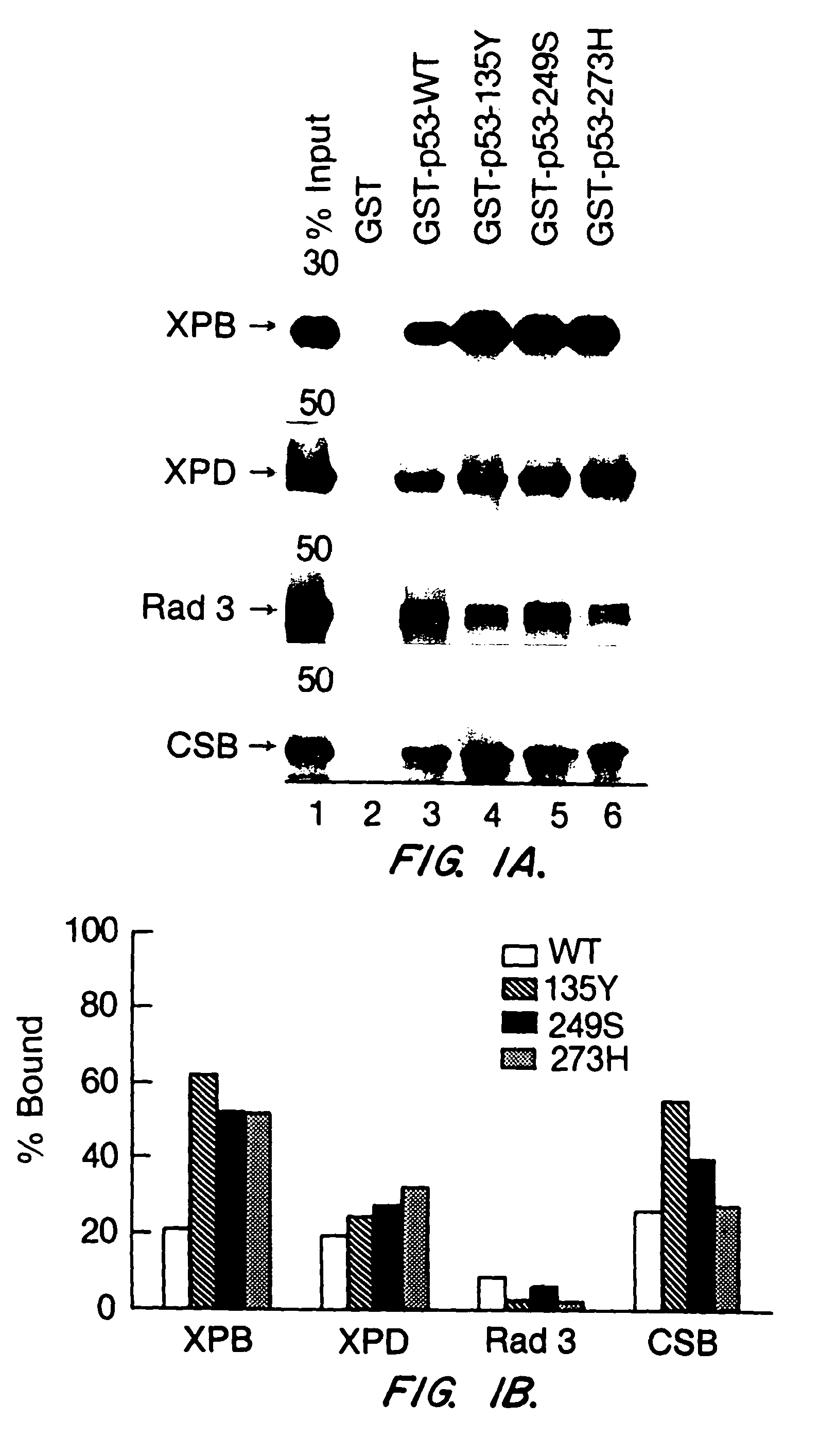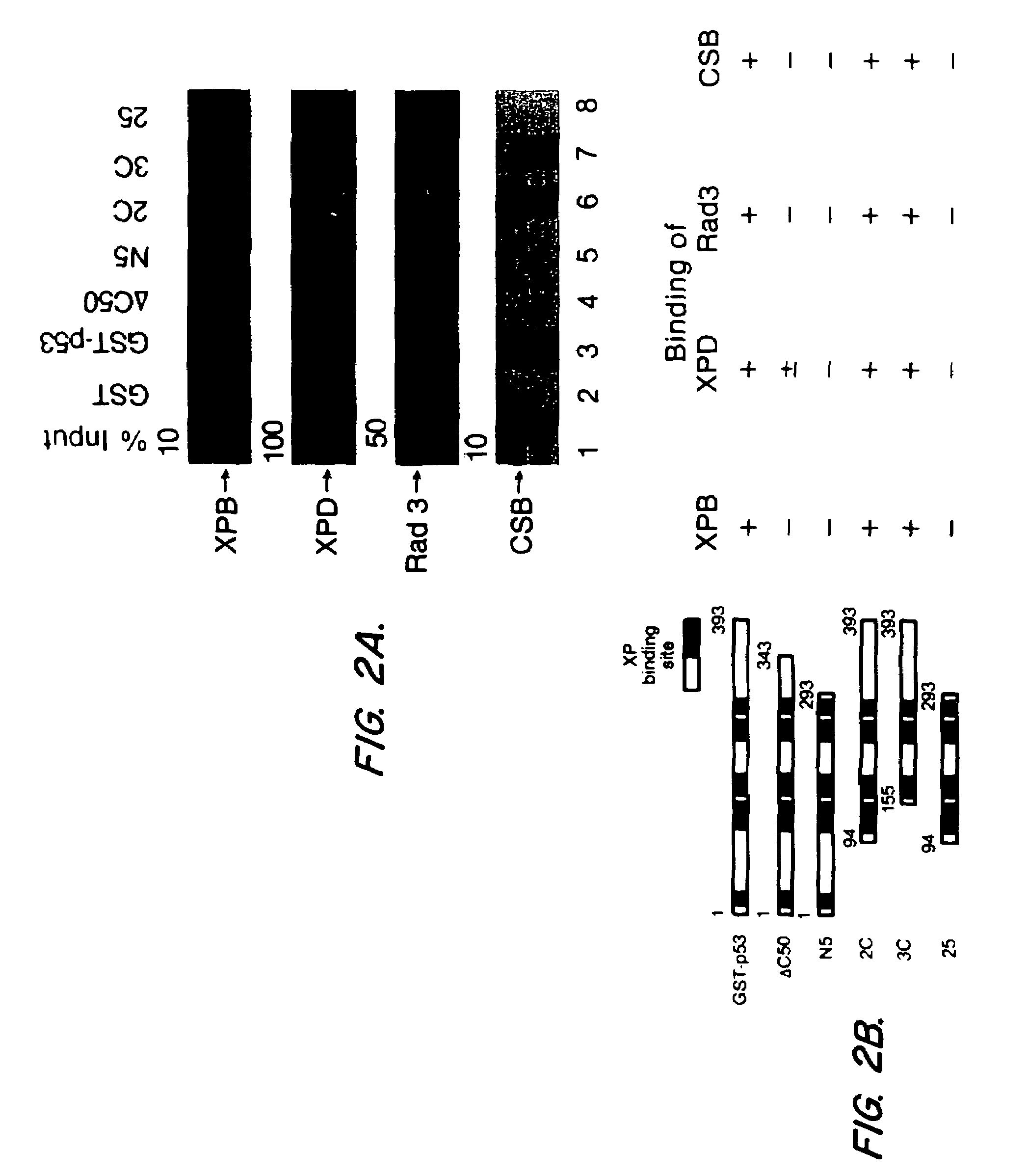Screening assays for compounds that cause apoptosis
a technology of apoptosis and assays, applied in the direction of p53 protein, peptide sources, instruments, etc., can solve the problems of p53 gene product interference, p53 protein product interference, etc., and achieve the effect of inhibiting helicase activity
- Summary
- Abstract
- Description
- Claims
- Application Information
AI Technical Summary
Benefits of technology
Problems solved by technology
Method used
Image
Examples
example 1
Production of Recombinant Proteins
A. Production of Expression Plasmids:
[0059]GST-p53-WT encodes glutathione S-transferase (GST) fused to human wild type p53. GST-p53-135Y, -249S, and -273H encode GST fused to p53 mutated at codon 135 (his→tyr), 249 (arg→ser), and 273 (arg→his), respectively. The production of these constructs are described in Wang, X. W., et al. (1994) Proc. Natl. Acad. Sci. USA 91:2230-2234. ΔC50 encodes a GST-p53 fusion protein with a deletion of the last 50 amino acids. ΔC50 was made by PCR amplification of the first 1,028 nucleotides (nt) of p53 from pC53-SN, (obtained from of Bert Vogelstein, Johns Hopkins University. Korn, S. E., Pietenpol, J. A., Thiragalingam, S., Seymour, A., Kirzler, K. W. and Vogelstein, B., Science 256:827-830, 1992. The PCR product was inserted into the BamHI site of pGEX-2T (Pharmacia LKB, Uppsala, Sweden). Plasmids N5, 2C, 3C, and 25 as described in Ruppert, J. M. and Stillman, B., (1993) Mol. Cell Biol. 13:3811-3820 encode GST fused ...
example 2
Binding of Wild Type and Mutant p53 With Nucleotide Excision Repair (NER) Proteins
A. Binding of Wild Type p53
[0062]In order to demonstrate that wild type p53 interacts with NER proteins, human wild type p53 protein was tagged at the N-terminus with glutathione S-transferase (GST) as described in Example 1. p53 protein was incubated with in vitro translated 35S-labeled XPD, Rad3, XPB, or CSB protein, which were also produced as described in Example 1. The binding assays were done in 500 μl IP buffer (50 mM Tris-HCl, pH8.0 / 120 mM NaCl / 0.5% Nonidet P-40) containing the 35S-labeled, in vitro translated proteins and GST fusion proteins loaded on GSH-beads at RT for 60 min. After washing five times with IP buffer, the bound proteins were released by boiling the beads in Laemmli buffer for 5 min, separated by SDS-PAGE, and visualized by flurography, as described in Wang, X. W., et al. (1994) Proc. Natl. Acad. Sci., USA 91:2230-2234. The results are shown in FIG. 1. XPD, XPB and CSB bind to...
example 3
Binding of Mutant p53 Proteins with C-terminal Deletions to Nucleotide Excision Repair (NER) Proteins
[0064]Defining the protein domains required for various interactions can provide clues to the significance of the interaction, especially if the domains are functionally important. The importance of the C-terminal domain of p53 for binding to NER proteins was demonstrated by the use of mutant p53 proteins with C-terminal deletions that were tagged with GST. The deletion mutant p53-GST fusion proteins were prepared as described in Example 1 herein, and binding studies to NER proteins were performed as described in Example 2 herein. The results are shown in FIG. 2.
[0065]Deletion of the 50 C-terminal amino acids abolished binding of XPB, Rad3 or CSB, and reduced binding of XPD, while deletion of up to 155 N-terminal amino acids had no detectable effect (see FIG. 2). XPD binding diminished with deletion of the 100 C-terminal amino acids (FIG. 2A, comparing lane 5 to lane 3). The effect o...
PUM
 Login to View More
Login to View More Abstract
Description
Claims
Application Information
 Login to View More
Login to View More - R&D
- Intellectual Property
- Life Sciences
- Materials
- Tech Scout
- Unparalleled Data Quality
- Higher Quality Content
- 60% Fewer Hallucinations
Browse by: Latest US Patents, China's latest patents, Technical Efficacy Thesaurus, Application Domain, Technology Topic, Popular Technical Reports.
© 2025 PatSnap. All rights reserved.Legal|Privacy policy|Modern Slavery Act Transparency Statement|Sitemap|About US| Contact US: help@patsnap.com



